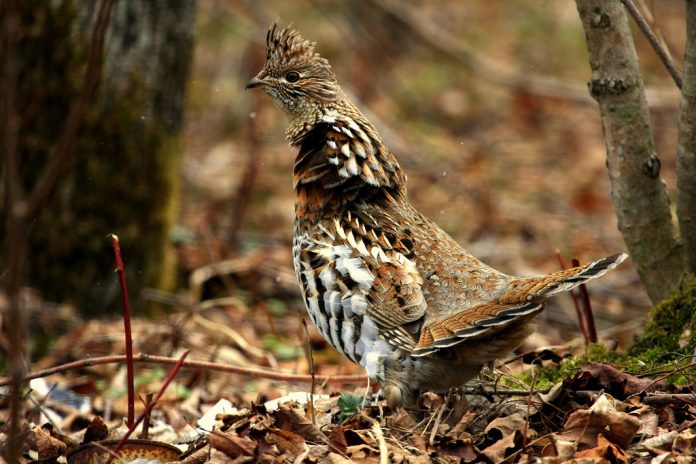
For nearly 25 years, unpredictable fluctuations of ruffed grouse populations in the Appalachian region have frustrated wildlife biologists in many states.
Known for five- or six-year population cycles in northern states characterized by evergreen and aspen forests, ruffed grouse populations in Appalachia have been declining for decades.
Ruffed grouse are cryptically colored, crested, chicken-like forest birds. They occur in both gray and red forms and are often impossible to see in dense understory vegetation.
States
In 1995, biologists in West Virginia began a long-term research project to search for answers. The next year Maryland, Virginia, Kentucky, and Ohio joined the project.
Eventually, Pennsylvania, Rhode Island, North Carolina, and Tennessee became part of this massive long-term project.
Ultimately, from September 1996 to October 2002, biologists captured and studied the habitat and movements of 3,118 grouse from the participating states.
Among the many results, habitat differences between Appalachian areas and the Great Lake states proved critical. Aspen forests offer better food and cover for grouse than deciduous forests further south in Appalachia.
Decline
Meanwhile, biologists at the Pennsylvania Game Commission carefully monitored their grouse populations. From 2001 to 2005, the ruffed grouse population suffered a 63 percent decline in Pennsylvania.
No one understood why, but in 2015 through 2016, biologist Lisa Williams and her team confirmed their suspicions that Pennsylvania grouse were being affected by West Nile virus.
Grouse chicks were hatched from eggs gathered in the wild, and then inoculated with West Nile virus. Within the first week, 40 percent of the chicks died.
After two weeks, an additional 40 percent of the chicks showed so much organ damage that they probably could not have survived in their natural environment.
The laboratory findings were then tested on wild grouse in Pennsylvania by looking for West Nile virus-positive antibodies in harvested grouse.
This testing is the first of its kind where lab results were then tested in wild populations.
Williams recruited hundreds of hunters across the state to send in blood samples when they harvested a grouse during the hunting season.
Game Commission pathologist Justin Brown and his research partners at Colorado State University and the University of Guelph then did the careful lab work to assess West Nile virus exposure in wild grouse.
By incorporating these findings into habitat management planning, the Game Commission and partners hope to direct habitat management efforts to areas where grouse populations have the best chance of responding.
Williams’ research then caught the attention of one of the Game Commission staff filmmakers. Tracy Graziano set out to tell Williams’ story.
Film project
Graziano completed the 9-minute documentary in late January 2017 after 18 months of shooting and countless hours in the field.
“The most rewarding thing I can hope for in any of my film projects is to help influence change for the benefit of wildlife and conservation,” said Graziano.
The intersection of Williams’ and Graziano’s work is a perfect example of how old-fashioned field biology (time, patience, persistence and hard work), high tech methods (video and blood work), and cooperation between hunters and state wildlife personnel can help solve large-scale, perplexing problems.
Kudos to Williams, Graziano, and all involved.
“With more than 27,000 YouTube views to date, I believe the Ruffed Grouse film was critically important in raising awareness among hunters about the risk of West Nile virus to grouse and is one of the reasons other state wildlife agencies started looking into West Nile virus as a contributing cause of decreasing grouse populations,” Williams said.
Game Commission Executive Director Bryan Burhans concurs. “Lisa Williams’ research into the ruffed grouse population decline in Pennsylvania is cutting-edge science-based wildlife management,” Burhans said.
“Documenting these important findings by using the latest technology by skilled filmmaker Tracy Graziano so others can learn and benefit exemplifies why the Pennsylvania Game Commission is at the forefront in modern wildlife management.”
Ruffed Grouse has already won seven awards at film festivals. Watch it at youtube.com by searching for “ruffed grouse.”
It is not only a fascinating look at modern wildlife management, it also gives a real sense of what wildlife biology is all about. And Graziano’s exceptional footage is an unexpected bonus.












